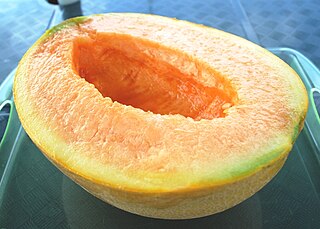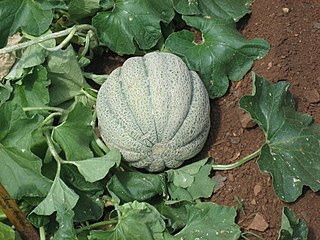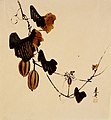
The cantaloupe is a type of true melon from the family Cucurbitaceae. Originally, cantaloupe referred only to the non-netted, orange-fleshed melons of Europe, but today may refer to any orange-fleshed melon of the C. melo species, including the netted muskmelon which is called cantaloupe in North America, rockmelon in Australia and New Zealand, and spanspek in Southern Africa. Cantaloupes range in mass from 0.5 to 5 kilograms.

The cucumber is a widely-cultivated creeping vine plant in the family Cucurbitaceae that bears cylindrical to spherical fruits, which are used as culinary vegetables. Considered an annual plant, there are three main types of cucumber—slicing, pickling, and seedless—within which several cultivars have been created. The cucumber originates in Asia extending from India, Nepal, Bangladesh, China, and Northern Thailand, but now grows on most continents, and many different types of cucumber are grown commercially and traded on the global market. In North America, the term wild cucumber refers to plants in the genera Echinocystis and Marah, though the two are not closely related.

A melon is any of various plants of the family Cucurbitaceae with sweet, edible, and fleshy fruit. The word "melon" can refer to either the plant or specifically to the fruit. Botanically, a melon is a kind of berry, specifically a "pepo". The word melon derives from Latin melopepo, which is the latinization of the Greek μηλοπέπων (mēlopepōn), meaning "melon", itself a compound of μῆλον (mēlon), "apple", treefruit " and πέπων (pepōn), amongst others "a kind of gourd or melon". Many different cultivars have been produced, particularly of cantaloupes.

Celadon is a term for pottery denoting both wares glazed in the jade green celadon color, also known as greenware or "green ware", and a type of transparent glaze, often with small cracks, that was first used on greenware, but later used on other porcelains. Celadon originated in China, though the term is purely European, and notable kilns such as the Longquan kiln in Zhejiang province are renowned for their celadon glazes. Celadon production later spread to other parts of East Asia, such as Japan and Korea, as well as Southeast Asian countries, such as Thailand. Eventually, European potteries produced some pieces, but it was never a major element there. Finer pieces are in porcelain, but both the color and the glaze can be produced in stoneware and earthenware. Most of the earlier Longquan celadon is on the border of stoneware and porcelain, meeting the Chinese but not the European definitions of porcelain.

Pyrus pyrifolia is a species of pear tree native to southern China and northern Indochina that has been introduced to Korea, Japan and other parts of the world. The tree's edible fruit is known by many names, including Asian pear, Persian pear, Japanese pear, Chinese pear, Korean pear, Taiwanese pear, apple pear, zodiac pear, three-halves pear, papple, naspati and sand pear. Along with cultivars of P. × bretschneideri and P. ussuriensis, the fruit is also called the nashi pear. Cultivars derived from Pyrus pyrifolia are grown throughout East Asia, and in other countries such as India, Pakistan, Nepal, Australia, New Zealand, and the United States. Traditionally in East Asia the tree's flowers are a popular symbol of early spring, and it is a common sight in gardens and the countryside.
The Bailan melon is a locally famous melon grown near Lanzhou, the capital city of Gansu province in the People's Republic of China. It is a variety of honeydew melon, globose to subglobose and typically has white skin with sweet, white or pale green, flesh. In photographs, the melons appear light yellow, orange or white, with a light green or apricot yellow flesh, which makes it similar in appearance to other types in the cultivar group of true melon. It is also heavy due to the density of the fruit's inner flesh. Like other types of honeydews, the Bailan melon is rich in Vitamin C and protein.

The Armenian cucumber, Cucumis melo Flexuosus Group or Cucumis melo var. flexuosus, is a type of long, slender fruit which tastes like a cucumber and looks somewhat like a cucumber inside. It is actually a variety of true melon, a species closely related to the cucumber. It is also known as the yard-long cucumber, snake cucumber, snake melon, chanbar in Persian, tirozî in Kurdish, sheng in Semnani, uri in Japanese, acur in Turkish, kakadee in Hindi, tar in Punjabi, قثاء in Arabic, commarella or tortarello in Italian. It should not be confused with the snake gourds. The skin is very thin, light green, and bumpless. It has no bitterness and the fruit is almost always used without peeling. It is also sometimes called a gutah.

The honeydew melon is one of the two main cultivar types in Cucumis melo Inodorus Group. It is characterized by the smooth rind and lack of musky odor. The other main type in the Inodorus Group is the wrinkle-rind casaba melon.

Solanum muricatum is a species of evergreen shrub native to South America and grown for its sweet edible fruit.
The Jenny Lind melon is an heirloom cantaloupe first introduced in the 1840s. Unlike most other types of cantaloupe, its flesh is light green, rather than orange. A typical fruit weights between one and two pounds, and has a distinct knob, often known as a turban, on one end.

The Yubari King is a cantaloupe cultivar farmed in greenhouses in Yūbari, Hokkaido, a small city close to Sapporo.

Cucumis melo, also known as melon, is a species of Cucumis that has been developed into many cultivated varieties. The fruit is a pepo. The flesh is either sweet or bland, with or without a musky aroma, and the rind can be smooth, ribbed, wrinkled, or netted. In North America, the sweet-flesh varieties are often collectively called muskmelon, including the musky netted-rind varieties and the inodorous smooth-rind varieties, and cantaloupe usually refers to the former type. However, muskmelon in a narrow sense only refers to the musky netted-rind type, also known as North American cantaloupe, while the true cantaloupe is the European type with ribbed and often warty rind that is seldom grown in North America.

Shonan Gold (湘南ゴールド) is a hybrid Japanese citrus, with a characteristic "golden" bright yellow color.
Ikuro Takahashi was a Japanese botanist, specializing in citrus, who was hailed as the "father of citrus" especially in his native Shizuoka Prefecture.

Ōgonkan or Ki-mikan are the common names for a small sized variety of Japanese citrus, whose rind is of a characteristic "golden" bright yellow color.

Melon necrotic spot virus (MNSV) is a virus that belongs to the genus Gammacarmovirus of the family Tombusviridae. It has been observed in several countries of the Americas, Africa, Asia, and Europe. It is considered to be an endemic virus in greenhouses and field productions of Cucurbitaceae crops, including melon, cucumber, and watermelon. MNSV is mainly spread through infected soil, seedlings, insects, and by the root-inhabiting fungus vector Olpidium bornovanus. Symptoms vary between Curbitaceae crops, but generally consist of chlorosis, brown necrotic lesions, leaf wilt, fruit decay, and plant death. Management of the disease consists of preventing infection by rotating fields and crops, steam sterilization, and disposal of infected plants. Also, treated seeds with heat or chemicals are efficient in preventing infection. MNSV is important in melon plants as it causes vast economical damage worldwide reducing significant yields.

The barattiere is a landrace variety of melon found in Southern Italy. It is common in the Apulia region of Italy and in the region of Sahel in Tunisia.

Shine Muscat is a diploid table grape cultivar resulted from a cross of Akitsu-21 and 'Hakunan' made by National Institute of Fruit Tree Science (NIFTS) in Japan in 1988. It has large yellow-green berries, crisp flesh texture, muscat flavor, high soluble solids concentration and low acidity. Nomenclature registration number is "Grape Agriculture and Forestry No. 21"「ぶどう農林21号」.
The kolkhoznitsa melon, also known as the collective farm woman melon, is a melon in the genus Cucumis native to Russia and introduced to the United States in 1993.














































